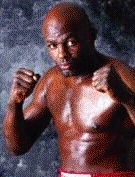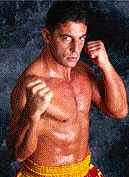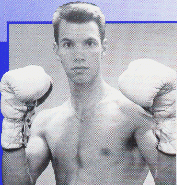MONDAY,
March 19th, 2001, 5:00 PM
The Kickboxing TALENT
Pool
By Alex McDonald - IKF Japan (3/19/01)
AS ON NEWS PAGE:
One of the interesting things about the sport of kickboxing is not only the
four rule classes but also where the fighters have come from. Some start as
kickboxing amateurs then move on to the pro ranks like amateur boxers move to
pro boxing but others come from various martial arts to create a fascinating
diversity.
The K-1 in Japan claims that its name comes from the combat arts that have
the letter K in them: karate, kung fu, taekwondo, kickboxing, etc. Muay Thai
fans tend to dislike the name because most K-1 fighters have some training in
Muay Thai, a martial art without a K. Some critics have even said the name K-1
comes from its founders name, Kazuyoshi Ishii (K-I). Regardless of
whether the top K-1 fighters are primarily from one background or not, the fact
remains that the K-1 has embraced all striking sports as a source of talent.
|

Ernesto Hoost
Muay
Thai, full contact, savate, etc
Has made it to the finals four times;
'93,
'97, '99 and '00,
winning three times ('97, '99 and '00).
|
|

Peter Aerts
Muay
Thai
Became the Grand Prix champion three times;
'94, '95 & '98.
|
|

Andy Hug
Karate
Was
the only fighter to make it to the finals 3 years in a row;
'96, '97 &
'98,
and the only karateka to win the GP ('96).
|
|

Mike Bernado
Boxing
Has
made it to the finals once;
'96
But is best remembered for the savage beatings he gave to
Hug in '95, Aerts in '96 and
 Jerome LeBanner (L) last week (March
17th '01). Jerome LeBanner (L) last week (March
17th '01). |
Let's now look at some of the different striking arts and see
how they might perform in the kickboxing ring.
CONTINUED FROM NEWS PAGE
BELOW
Let's now look at some of the different striking arts and see how they might
perform in the kickboxing ring.
- Hard Karate (Kyokushin
kai, seido kaikan, etc)
- Strikes:
- Punches: (bare knuckle)- To the body only.
- Kicks: To the legs, body and head.
- Elbows: To the body.
- Knees: To the body and head.
- Grappling: Holding is nearly non existent. When opponents get too
close they tend to push to open the area between them.
- Protective Equipment: Taping of injured areas is allowed. Otherwise
none.
- Aspects of Competition:
- Time: 2 min (1st and 2nd overtime extensions are also 2 minutes)
- Area: Flat surface.
- Scoring: A knock out or two knock downs will stop the match and
decide the winner. One knock down will decide the winner after the time has
expired. In the absence of a knock down the 4 judges will select the dominant
fighter as the winner. If no decision is reached the competitors will go into
overtime. If the overtime extension(s) still don't establish a winner the
fighters are weighed. If the smaller of the two is 10kg or more lighter he will
be named the winner of the match. If
 not, the
number of boards broken at the beginning of the event will decide the winner. At
the 1999 world championships, champion Francisco Filho (L) broke 22
boards whereas finalist Hajime Kazumi broke 19.
not, the
number of boards broken at the beginning of the event will decide the winner. At
the 1999 world championships, champion Francisco Filho (L) broke 22
boards whereas finalist Hajime Kazumi broke 19.
- Other- The elite kyokushin fighters are drawn to attempt what is called the
Hyakunin Kumite
which is basically a test that requires the karateka to fight 100 fighters in a
row. Losses during the test are tolerated provided the test taker doesn't finish
with a losing record or leave his feet. Being sent to the floor in one's last
match will mean failure. Francisco Filho completed his test in 3 hours 8
minutes with a record of 76 wins-0 losses-24 draws. (He
actually did it twice, within the short period of two months. The first time it
was in Brazil, and the second time in Japan. He then went on, in the same year,
to also place 3rd in the November 1995 World Kyokushin Championships. Filho's
bouts -Brazil- were 1 minute and 30 seconds each, and the event took 2 hours and
45 minutes to complete. The Japanese bouts were probably the regulation 2
minutes each, with no total time provided. (3 hours 8 min to complete.)
Hajime Kazumi completed his in 4 hours 4 minutes with a record of 58
wins- 0 losses- 42 draws.
- Hard Karate to Kickboxing:
- Probably the best example of a top level karateka successfully transferring
to the sport of kickboxing is the late Andy Hug who had placed 2nd in
the Karate World Championships in 1987. Hug had a very rough start in
kickboxing though, losing to American
 Patrick
Smith and South African Mike Bernado (both boxers). His
biggest problem was protecting his head from punches which were never allowed in
karate. By the end of his career he had adopted a style of defense that
resembled Floyd Patterson's (R) 'peek-a-boo'.
Patrick
Smith and South African Mike Bernado (both boxers). His
biggest problem was protecting his head from punches which were never allowed in
karate. By the end of his career he had adopted a style of defense that
resembled Floyd Patterson's (R) 'peek-a-boo'.
- Francisco Filho was an instant success. He fought slow paced fights
and when opponents decided to speed things up they wound up flat on their backs.
Ernesto Hoost exposed his first weakness; he could be outpointed. Mike
Bernado and Jerome LeBanner exposed the second; he could be knocked
out. Filho has since added two elements to his repertoire, a snappy jab
and the 'peek-a-boo' defense that gave Hug so much success.
- Taekwondo
- Strikes:
- Punches: (small gloves) to the body only.
- Kicks: To the body and head.
- Grappling: Some holding may happen but the referee then separates
the fighters.
- Protective Equipment: Headgear, mouthpiece, shin guards, groin
guard and chest protector.
- Aspects of competition:
- Time: 3 rounds x 3 minutes.
- Area: Flat surface.
- Scoring: The referee gives points for successful strikes to the
designated areas Taekwondo to kickboxing.
- In 1996, Isamu Hayami who was the Japanese ITF taekwondo champion
stepped in the ring against Yakayuki Murosaki who was trained at Muay
Thai. Hayami was quick, used the ring well and played a good hit and run
game but by not landing any hard strikes his opponent eventually lost respect,
chased him down and knocked him out cold.
 In 1997, Pierre Guenette
(R) faced Andy Hug in the opening round of the K-1 GP. Guenette
was completely unprepared for the differences between fighting on a mat and
fighting in a ring. Hug cut the ring off so well that Guenette
resorted to turning his back and running to get some room. His final mistake was
pushing with both hands to break a clinch which left him completely open for
Hug's right hook.
In 1997, Pierre Guenette
(R) faced Andy Hug in the opening round of the K-1 GP. Guenette
was completely unprepared for the differences between fighting on a mat and
fighting in a ring. Hug cut the ring off so well that Guenette
resorted to turning his back and running to get some room. His final mistake was
pushing with both hands to break a clinch which left him completely open for
Hug's right hook.- In 1998, Guenette fought Tsuyoshi Nakasako. This time he
tried to get some respect by throwing harder punches. Nakasako kept his
hands up and absorbed almost all of them in his gloves. Guenette's
strategy only got him exhausted. With no energy left all he could do was run.
The shocking thing was that, in terms of talent, Guenette completely
outclassed Nakasako but talent wasn't enough. He needed skills,
especially defensive skills. It was obvious that he could see every punch and
kick coming (he'd surely seen faster than Nakasako) but running
was only wearing him out and prolonging the inevitable. Never before and never
since have I seen a referee stop a fight because a fighter was too exhausted to
properly defend himself.
- It should be noted that a taekwondo artist may not have the TKD skills and
talents of Guenette or Hayami but be better suited for
kickboxing. Patrick Smith for example, with limited TKD and some boxing
skills managed a knockout win over Andy Hug. In fact, if one were to
take the top 20 TKD artists and have them compete against each other under
kickboxing rules, we'd find that there would be very little correlation between
the TKD rankings and the kickboxing rankings. That goes for most crossover
athletes. No one would believe, for instance, that Michael Jordan would
be the best basketball player turn boxer.
- Boxing:
- Strikes:
- Punches: (gloved) To the body and head (no spinning
backfist)
- Kicks: None.
- Grappling: Holding is a defensive maneuver. Too much holding though
can result in warnings, point deductions and even disqualification. The referee
is responsible for breaking up fighters in a clinch.
- Protective Equipment: Headgear (amateurs only), mouthpiece
and groin protector.
- Aspects of Competition
- Time: Amateur: 4 Rounds X 2 min, Pro: up to 12 rounds X 3 min.
- Area: Ring (a raised surface with ropes)
- Scoring: Amateur: The new system gives one point for every clean
strike. The judges are criticized for not counting body shots. Pro: 10 point
must system. The fighter who scores the most punches wins the round with 10
points, the loser is awarded 9 points. In the event of a knock down, the one
still standing is usually awarded the round (10 points) and the loser of
the round gets 8 points.
- Boxing to Kickboxing:
- Because of the number of promoters in boxing and the amount of money that
is made by elite boxers it is much more usual to see
 kickboxers transfer to boxing than the other way
around. One notable example is Vitali Klitschko who won 27 boxing
matches in a row by KO before losing to Chris Byrd. Anothers are
undefeated
kickboxers transfer to boxing than the other way
around. One notable example is Vitali Klitschko who won 27 boxing
matches in a row by KO before losing to Chris Byrd. Anothers are
undefeated IKF
North American FC Middleweight Champion Eric Regan (R) and past IKF U.S. Amateur FCR Champion Greg Kirkpatrick.
(L)
IKF
North American FC Middleweight Champion Eric Regan (R) and past IKF U.S. Amateur FCR Champion Greg Kirkpatrick.
(L)
- Mike Bernado, who now holds the WBF world title (boxing),
has had a fairly successful kickboxing career. In addition to a predominantly
punching style, he brought something a little unusual to the mix, head movement.
Where most karateka left their heads in one place he made his a difficult target
to hit. Even when he was punching his head was moving and hard for counter
attackers to hit. The drawback to this is that head movement requires the feet
to be well planted which can be dangerous against opponents with powerful low
kicks. On a few occasions, Bernado has had his legs kicked out.
 Rick Roufus (L, The night
he won his IKF Title) like many full
contact (FC) fighters has a wealth of boxing experience. His first fight in the
K-1 saw him matched against Jerome LeBanner. Although he was dominant
for most of the fight, his inexperience
Rick Roufus (L, The night
he won his IKF Title) like many full
contact (FC) fighters has a wealth of boxing experience. His first fight in the
K-1 saw him matched against Jerome LeBanner. Although he was dominant
for most of the fight, his inexperience in
leg kick matches cost him the match. He has since devoted himself to developing
his skills in this type of match and by defeating Stan Longinidis (R,
After his bout with Roufus) has become the IKF
International Rules Heavyweight Champion of the World.
in
leg kick matches cost him the match. He has since devoted himself to developing
his skills in this type of match and by defeating Stan Longinidis (R,
After his bout with Roufus) has become the IKF
International Rules Heavyweight Champion of the World.
- Savate (or La Boxe Française):
- Strikes:
- Punches (gloved) To the body and head.
- Kicks: (shoed) To the legs, body and head (kicks must
out number punches)
- Grappling:
- Since any holding will stop the clock, it is arguable that grappling is non
existent in this sport.
- Protective Equipment: Headgear: (amateurs only),
mouthpiece, groin protector. The gloves are a little longer than boxing gloves
to protect the wrist from being injured by the shoes.
- Aspects of the Competition:
- Time: 2 to 5 rounds X 1 or 1½ or 2 minute(s). The referee stops the
time to break clinches.
- Area: Ring.
- Scoring: This is a kicking art and more points are given for kicks
than punches. Punches-one point. Low kick- one point. Middle kick- two points.
High kick- three points.
- Savate to Kickboxing:
- In 1988, Ernesto Hoost of the Netherlands won the European Savate
Championships in the middleweight division. He has since been in the K-1 Grand
Prix final 4 times winning three times. It should be noted that Hoost is
not a pure savateur. He has fought under many different rules on his way to
earning the nickname 'Mr. Perfect'. One example was his desire to fight Rick
Roufus under full contact rules, pretty gutsy for a man to surrender such
great low kicks.
- Gerard Gordeau who is famous for fighting Royce Gracie in
the final of the first UFC, also fought in the K-1 in the early '90s but never
managed to win a match.
- San Shou (or shoot
boxing)
- Strikes:
- Punches: To the body and head.
- Kicks: To the legs, body and head.
- Grappling: Holding is accepted and points are given for throws.
Hitting while holding is not allowed.
- Protective Equipment: Headgear (amateurs), shin guards (amateur),
mouthpiece and groin protector.
- Aspects of the Contest:
- Time: Up to 8 rounds x 2 minutes (pro) or up to 5 rounds x
2 minutes (amateur)
- Area: Raised surface without ropes or a standard kickboxing ring.
- Scoring: 10 point must system plus 0-3 points for throws.
- San Shou to Kickboxing
- Actually, san shou is a sanctioned event in the IKF
and therefore it is kickboxing. Some fighters have however changed rule classes.
- Teng Jun and An Hu of China stepped into the K-1 ring to
compete in the K-1 Japan. They seemed to have a lot of trouble with the
grappling. They either were in a great position for a throw or were being held
and kneed (there is no holding and hitting in san shou and there are no knee
strikes). Teng Jun has shown that he too had tricks up his sleeve.
We usually see heavy fighters exhaust smaller fighters in the clinches but Teng's
extensive grappling experience is always tiring for any opponent. Even Nobu
Hayashi, who outweighed him by about 25 kg, (55 lbs) was gasping for
air by the end of their bout.
- As a crossover sport, San Shou may also be attractive for NHB fighters who
want to work exclusively on their standing game: from strikes to throws.
- Muay Thai:
- Strikes:
- Punches: (gloved) To the body and head.
- Elbows: To the body and head.
- Kicks. To the legs, body and head.
- Knees: To the body and head.
- Grappling: Extended holding is permitted as is holding (the
neck and head) and hitting (especially knees). Throws are not
allowed.
- Protective Equipment: Headgear: (amateurs), shinguards (amateurs),
elbow pads (amateurs), mouthpiece, groin protector.
- Aspects of the Competition:
- Time: 5 three minute rounds (3x2 for amateurs)
- Area: Ring.
- Scoring: Since Muay Thai is viewed as a sport in the IKF, it is scored on a 10 point must system. In
Thailand though, it is scored like a fight so if the judges feel fighter A
controlled the fight even if he were hit more times, they will declare him the
winner.
- MuayThai to Kickboxing:
- Muay Thai enthusiasts may feel there is a world of difference between their
beloved sport and kickboxing but the IKF
does sanction Muay Thai under the umbrella term of kickboxing. Furthermore,
there have been crossover matches where Thai fighters fought under compromised
rules or western kickboxers fought in Thailand.
- Full Contact:
- Strikes:
- Punches: (gloved) To the body and head.
- Kicks: (padded footwear) To the body and head. Minimum of 6
kicks (amateur) or 8 kicks (pro) thrown per round.
- Grappling: Defensive holding may take place but it is the
responsibility of the referee to break any clinches.
- Protective Equipment: Headgear (amateurs only), shinguards
(amateur), foot pads, mouthpiece and groin protector.
- Aspects of Competition:
- Time: Amateur: 3 to 5 rounds X 2 minutes. Pro: 5 to 12 rounds X 2
minutes.
- Area: Ring.
- Scoring: 10 point must system. The biggest difference is that
points are deducted for not throwing the required number of kicks. One point is
deducted for the first inadequate round, two for the second, three for the third
and so on.
- Full Contact to Kickboxing
- Again this is a sanctioned rule style
 in the IKF so it is therefore under the
umbrella term of kickboxing. Probably the most successful fighters to make the
switch from FC to IR is Rick Roufus (R) who now holds the IKF Heavyweight World Title.
in the IKF so it is therefore under the
umbrella term of kickboxing. Probably the most successful fighters to make the
switch from FC to IR is Rick Roufus (R) who now holds the IKF Heavyweight World Title.
- International Rules Kickboxing
(Leg Kick)
- Strikes:
- Punches: (gloved) To the body and head.
- Kicks: To the legs (not to the knees), body and head.
- Grappling: As in boxing, holding may happen but it is the
responsibility of the referee to break up any clinches. There is neither
throwing nor holding and hitting.
- Protective Equipment: Headgear (amateurs), shin guards (amateurs),
mouthpiece, and groin protector.
- Aspects of Competition:
- Time: Amateur 3 X 2 minute rounds. Pro: up to 10 X 2 minute rounds.
- Area: Ring.
- Scoring: Standard 10 point must scoring.
- Kickboxing Crossovers
- In the IKF National Amateur Tournament,
this set of rules is regarded by fighters and trainers as the neutral rules. If,
for instance, a san shou competitor and a MT fighter are without opponents, they
will view IR as the neutral ground and compromise (though purists will see
no value and walk out).
Conclusion
Many spectators view martial arts simply by the techniques used or the rules
of their contests. We hear things like 'Why don't karate guys just put on
gloves and punch to the head?' The reason is in the approach the martial art
takes as its ultimate purpose. Although many martial arts are also competitive
sports, they are primarily for self defense. The reason hard karate fighters
fight with bare knuckles is simply that if attacked by someone on the street,
they will not have time to slip on a pair of gloves. Also, how many of the first
UFC fighters trained with gloves then broke bones in their hands fighting bare
knuckle? I can think of a few.
The reason TKD fighters throw quick kicks and
retreat is because disengaging from a fight is a very safe and sensible thing to
do. Think about it. What are referees in the ring for? To make sure there is a
fight. (As well as for the safety of the fighters of course) If a
fighter stepped into the ring with a strategy of holding and running, he'd
probably look okay after the fight (at least until the promoter got a hold
of him). So, standing toe to toe on the street with some criminal (it is
a crime after all to attack people on the street) is therefore trained out
of these students.
Despite all the style bashing we often hear, I believe every style has
something to offer the sport of kickboxing and in return the sport of kickboxing
may have something to offer martial artists: a pro career.
The purpose of
the IKF National Amateur Tournament, is
to give amateurs the chance to gain experience with fighters from around the
country. It is so sad to see fighters with few amateur fights turning pro due to
lack of competition. Or someone with a number of hometown fights challenging for
a world amateur title with an irresponsible sanctioning organization. It is also
a shame to see very talented martial artists step into a ring for the first time
as a pro and oblivious to the dangers they face. It is fine for the K-1 to
embrace different fighting styles but it's simply unwise for the athletes to
make the transition from amateur to pro at the same time as they make the
transition from their style to that of kickboxing.
Having said that, I would like to recommend fighters from the amateur
martial arts community to register for future IKF
National Amateur Tournaments. I strongly believe that the protective
equipment will reduce the risk of injury and give you the chance to showcase
your talents. Naturally, I don't expect to see a wave of crossover fighters.
Some purists feel the rules of their competitions are as much a part of the art
as the techniques and the underlying approach. For those, however, who feel the
approach and the techniques could apply to different rule systems, I'm sure the
IKF will welcome you. Spread the word.
Back To Main OPINION PAGE,
Click HERE!
Back To The
NEWS PAGE, Click HERE!
Back
To The IKF
HOME PAGE, Click HERE!




 Jerome LeBanner (L) last week (March
17th '01).
Jerome LeBanner (L) last week (March
17th '01). not, the
number of boards broken at the beginning of the event will decide the winner. At
the 1999 world championships, champion Francisco Filho (L) broke 22
boards whereas finalist Hajime Kazumi broke 19.
not, the
number of boards broken at the beginning of the event will decide the winner. At
the 1999 world championships, champion Francisco Filho (L) broke 22
boards whereas finalist Hajime Kazumi broke 19. Patrick
Smith and South African Mike Bernado (both boxers). His
biggest problem was protecting his head from punches which were never allowed in
karate. By the end of his career he had adopted a style of defense that
resembled Floyd Patterson's (R) 'peek-a-boo'.
Patrick
Smith and South African Mike Bernado (both boxers). His
biggest problem was protecting his head from punches which were never allowed in
karate. By the end of his career he had adopted a style of defense that
resembled Floyd Patterson's (R) 'peek-a-boo'. In 1997, Pierre Guenette
(R) faced Andy Hug in the opening round of the K-1 GP. Guenette
was completely unprepared for the differences between fighting on a mat and
fighting in a ring. Hug cut the ring off so well that Guenette
resorted to turning his back and running to get some room. His final mistake was
pushing with both hands to break a clinch which left him completely open for
Hug's right hook.
In 1997, Pierre Guenette
(R) faced Andy Hug in the opening round of the K-1 GP. Guenette
was completely unprepared for the differences between fighting on a mat and
fighting in a ring. Hug cut the ring off so well that Guenette
resorted to turning his back and running to get some room. His final mistake was
pushing with both hands to break a clinch which left him completely open for
Hug's right hook. kickboxers transfer to boxing than the other way
around. One notable example is Vitali Klitschko who won 27 boxing
matches in a row by KO before losing to Chris Byrd. Anothers are
undefeated
kickboxers transfer to boxing than the other way
around. One notable example is Vitali Klitschko who won 27 boxing
matches in a row by KO before losing to Chris Byrd. Anothers are
undefeated IKF
North American FC Middleweight Champion Eric Regan (R) and past IKF U.S. Amateur FCR Champion Greg Kirkpatrick.
(L)
IKF
North American FC Middleweight Champion Eric Regan (R) and past IKF U.S. Amateur FCR Champion Greg Kirkpatrick.
(L) Rick Roufus (L, The night
he won his IKF Title) like many full
contact (FC) fighters has a wealth of boxing experience. His first fight in the
K-1 saw him matched against Jerome LeBanner. Although he was dominant
for most of the fight, his inexperience
Rick Roufus (L, The night
he won his IKF Title) like many full
contact (FC) fighters has a wealth of boxing experience. His first fight in the
K-1 saw him matched against Jerome LeBanner. Although he was dominant
for most of the fight, his inexperience in
leg kick matches cost him the match. He has since devoted himself to developing
his skills in this type of match and by defeating Stan Longinidis (R,
After his bout with Roufus) has become the IKF
International Rules Heavyweight Champion of the World.
in
leg kick matches cost him the match. He has since devoted himself to developing
his skills in this type of match and by defeating Stan Longinidis (R,
After his bout with Roufus) has become the IKF
International Rules Heavyweight Champion of the World. in the IKF so it is therefore under the
umbrella term of kickboxing. Probably the most successful fighters to make the
switch from FC to IR is Rick Roufus (R) who now holds the IKF Heavyweight World Title.
in the IKF so it is therefore under the
umbrella term of kickboxing. Probably the most successful fighters to make the
switch from FC to IR is Rick Roufus (R) who now holds the IKF Heavyweight World Title.